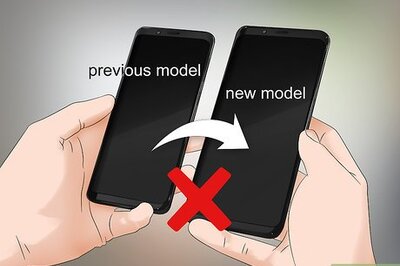
views
Late last night, Google teased the first glimpse of its upcoming annual smartphone, the Pixel 4. With Twitterverse going into a frenzy with the surprise reveal, we got a glimpse of how the phone would look from the rear. Unfortunately, to the disappointment of many, Google appears to have opted for a square housing that raises a bump off the rear surface, and while that does means a multi-camera setup that should possibly be the best ever in a line of already-loved phone cameras, it also means the death of minimal, symmetric design.
Mobile phone designs were an exciting aspect once upon a time. About a decade ago, buying a mobile phone meant you could get something as outrageous as the Nokia 7280, aka ‘The Lipstick Phone’, or the 180-degree swivelling Sony Ericsson W600i. Fast forward to now, and innovation has brought internet, heavy computing power and cameras competent enough to challenge dedicated imaging tools to mobile phones. However, despite many attempts, most smartphones have sacrificed the design bit to look rather similar to each other.
While even that was acceptable, OEMs are now trying to pack in as many cameras as possible on the back of their devices. This has led to them trying to arrive at the most ideal arrangement for doing so, by creating a housing that will have all the lenses and their paired image sensors underneath, spacing out a dedicated imaging corner inside the body of the phone. Going by the newly revealed teaser for the Google Pixel 4 and the multitude of leaks about the 2019 Apple iPhones, it seems that this camera housing at the back of each phone will be large, square and ungainly.
Collateral damage
Given the emphasis that companies such as Apple and Google put on minimalistic design approaches, it is a bit of a conundrum to see such product design come to fruition. However, putting one-way blame at the companies would be wrong. Today’s consumers have come to expect a whole lot from their smartphones than just utilitarian approaches. For instance, any standard smartphone today comes with a processor that is capable of some degree of multitasking, multiple cameras that can provide optical zooming, stereo speakers for a cinematic aural experience, and much more.
These factors were practically non-existent about a decade ago, when the best phone cameras had 2-megapixel sensors, and movie themes were actively converted into polyphonic ringtones. As a result, there was a far greater emphasis on phone design, and much lesser stress on a phone’s capabilities as a camera. Given the present scenario, we couldn’t help wonder if amidst the rubble of innovation, design became a collateral damage and took a hit.
Apple and Google are not the only ones — HMD’s penta-camera Nokia 9 PureView has a design that can irk those who have (trigger alert!) trypophobia. While it is more symmetric than putting a large box with three lenses at one corner of a device, it is still far from ideal. Huawei-owned Honor appears to have gotten a better hang of things with arranging the cameras at the back, with its vertical line approach to camera alignment.
Compulsion for change
However, even if a company cracks the design language, it is not possible for them to stick to it forever. Apple has felt the effect of design stagnation more than anyone else — its design language essentially did not change for four years, between the iPhone 6 of 2014 and the iPhone 8 of 2017. Software innovation also became incremental, which coincided with the rise of Android as a more appealing ecosystem, and now, the company is struggling with shipment figures.
As a result, Huawei too cannot stick to the same design language forever, and at some point, would be compelled to have a new design element in its phones. Would they still be able to stick to minimalism and symmetry with the new design language? Right now, Apple and Google seem to have lost out on the phone design front, and while it will still find takers, a square bump placed at one corner of a rear glass panel is far from ideal.
In hindsight, the square camera hump is still better than the cyclops-like design concept that had surfaced for 2019 iPhones, a few months ago.



















Comments
0 comment